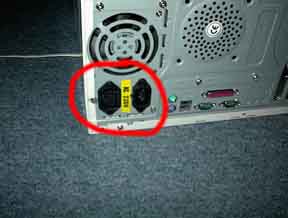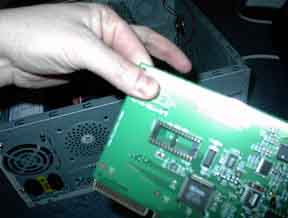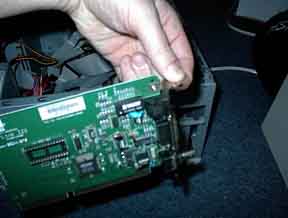The
latest version
|
How
to get NetBSD
Firewall |
Questions you should have
|
Is
it useful for me? |
How to install it
|
Getting
the hardware ready |
Full technical disclosure
Related technical resources
|
Sites
with information |
Let us know!
Usually your computer already is set up to work, unless you've canabalized it for spare parts in the past. If you've got a computer that runs windows, most of the time all you need to do is an a second ethernet card. So that's all we really explain here.
The most imporant precautions you need to take are to make sure you do not damage the computer when installing the second card, or damage yourself. So here's a few precautions:
First, unplug the computer. Never fiddle with it with the power still on. Just to drive the point home, here's a picture of the back of your computer with the power cable removed:

If you've unplugged the computer, open the box, and locate the place where the cards are plugged in. It will most likely look something like this:

Now here's the part about precautions. Modern electronics can be damaged by static electricity, and the best way to prevent this from happening is using a grounding strap. This is a simple piece of cable that you clip to the outside metal box of the power supply while you wrap the other around your wrist. Most stores that sell computer components should have one for you, and you can buy them at most generic electronic stores as well. If, for whatever reason, you can't get hold of one, here's another way to get some lesser form of protection. If you're right-handed, hold your left hand on the metal box of the power supply while you handle the cards with your right hand. Like this:

Boy, what a mess of cables in there... Anyway, when you handle the cards with your right hand, make sure you touch them only at a corner where there's no electronics, like this:

Yes, I know that's my left hand holding the card - but I had to hold the camera with my right hand... Alternatively, you can hold the card by it's metal strip, like this:

Place the card in a free slot in the computer, and tighten the screw that holds the metal strip to the computer box.
Next, you'll need to connect the ethernet cable that connects to your cable modem to the computer, as well as your local network to the second ethernet card. Here's the back-side of one fo the ethernet cards. This card can take all kind of network cable types, but the leftmost plug is probably the one you will use:

Once you've connected both networks, you can plug the power, keyboard, and monitor back in.
